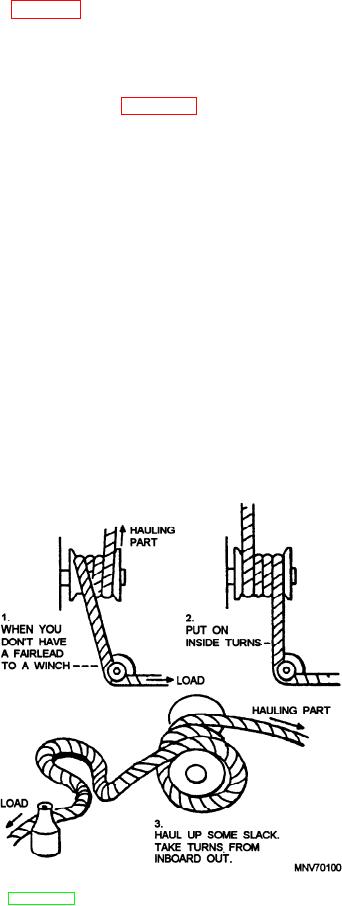
Line larger than 1 3/4 inches is designated by its
Distortions, Kinks, and Twists
circumference, in inches. A 5-inch line, for example, is
Most damage to a line occurs as the line is being
constructed of natural or synthetic fibers and measures
hauled in under a strain. The initial load on the line is
5 inches in circumference. In general, lines larger than 5
created as the line coils onto the winch. If a line does not
inches are called hawses, which are available in sizes up
lead fairly to a winch drum (90 to the drum axis), it will
to 21 inches.
become badly distorted as it is heaved in. Notice in view
1 of figure 4-4 that the line from the load approaches the
drum at an angle other than 90. If a strain is put on the
CARE AND HANDLING OF LINE
line in this situation, the line will become fouled on the
It is not news to experienced Seamen that misuse
drum and may be damaged. To keep the line from
and abuse of their gear shortens its life. Yet, because of
fouling and becoming damaged, it must be changed as
carelessness and lack of knowledge, line is the one item
shown in view 2 of figure 4-4. This involves putting
that receives more abuse than any other equipment the
turns of line inside (toward the base of the drum) of the
Seaman uses. Also, line in a doubtful condition puts
part from the load so the line feeds onto the drum at a 90
more lives in jeopardy than any other gear. Therefore,
angle. Because the outside end is attached to the load
you should learn and exercise the proper care and
and is unavailable, enough slack must be hauled up in
methods of handling line.
the hauling part to make the necessary number of turns.
The turns should be started inboard, as shown in the
NATURAL-FIBER LINES
figure.
Whenever possible, a right-laid line should be put
Coils of line should always be stowed on shelves or
on a winch drum or capstan right-handed or in
platforms clear of the deck. They should never be
clockwise turns. Heaving on a right-laid line with left-
covered with an accumulation of junk that may prevent
handed turns will eventually kink the line. About the
the evaporation of moisture, because line composed of
only time left-handed turns cannot be avoided is when a
vegetable (natural) fiber is susceptible to mildew and
winch is heaving on two lines at once, one on each
rotting if it stays wet.
drum.
Coils of large line should be stowed with their
A line with a kink in it or a cockle that is twisted
proper side up for opening. Line from 2 to 4 inches,
from having a dip in it should never be heaved hard
which will be needed in various lengths on deck, should
while that condition exists. A strong strain on a kinked
be opened, and a few feet of the end led out. Mooring
or twisted line will put a permanent distortion in the
line should not be opened until it is needed.
Whenever possible, line that has become wet in use
should be dried thoroughly before it is stowed.
Sometimes this is impossible, as with mooring lines,
which must be stowed before the ship clears port. If line
must be stowed wet, it should be laid up on grating in
long fakes or suspended in some way that will allow it to
dry as quickly as possible. It should never be covered
before it is dry.
Stretch and, usually, elongation occur when
natural-fiber line under tension is wetted down. The
line shrinks in diameter, adding more strain. When the
line dries, it does not recover to its original size and
shape. Thus its length is increased and its diameter and
strength are decreased. New line, which still contains a
large amount of its original waterproofing oil, does not
shrink as much as old line, from which much of the oil
has dissipated through exposure. Nevertheless,
whatever the condition, taut lines, such as boat falls,
must be slacked when it begins to rain or when spray
begins to wet them.
Figure 4-4.--Putting on inside turns to get a fair lead.
4-3

